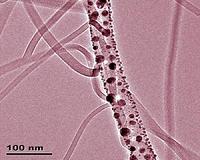 |
Hoboken NJ (SPX) Jul 12, 2010 The journal, NanoLetters, recently published an article highlighting the fascinating Nanogenerators developed by Dr. Yong Shi, a professor in the Mechanical Engineering Department at Stevens Institute of Technology. The paper was entitled, "1.6 V Nanogenerator for Mechanical Energy Harvesting Using PZT Nanofibers." Dr. Shi's work focuses on miniature energy harvesting technologies that could potentially power wireless electronics, portable devices, stretchable electronics, and implantable biosensors. The concept involves piezoelectric nanowire- and nanofiber-based generators that would power such devices through a conversion of mechanical energy into electrical energy. Dr. Shi uses a piezoelectric nanogenerator based on PZT nanofibers. The PZT nanofibers, with a diameter and length of approximately 60 nm and 500 micrometers, are aligned on interdigitated electrodes of platinum fine wires and packaged using a soft polymer on a silicon substrate. The measured output voltage and power under periodic stress application to the soft polymer was 1.63 V and 0.03 MicroWatts, respectively. This amazing breakthrough in piezoelectric nanofiber research has incredible potential to enable new technology development across a multitude of science and engineering industries and related research. "One of the major limitations of current active implantable biomedical devices is that they are battery powered. This means that they either have to be recharged or replaced periodically. Dr. Shi's group has demonstrated a technology that will allow implantable devices to recover some of the mechanical energy in flowing blood or peristaltic fluid movement in the GI tract to power smart implanable biomedical devices," says, Dr. Arthur Ritter, Director of Biomedical Engineering at Stevens. "The fact that his technology is based on nano-structures makes possible power supplies for nano-robots that can exist in the blood stream for extended periods of time and transmit diagnostic data, take samples for biopsy and/or send images wirelessly to external data bases for analysis."
Share This Article With Planet Earth
Related Links Stevens Institute of Technology Nano Technology News From SpaceMart.com Computer Chip Architecture, Technology and Manufacture
 Nanowires For The Electronics And Optoelectronics Of The Future
Nanowires For The Electronics And Optoelectronics Of The FutureZurich, Switzerland (SPX) Jun 25, 2010 Organic semiconductors are very promising candidates as starting materials for the manufacture of cheap, large area and flexible electronic components such as transistors, diodes and sensors on a scale ranging from micro to nano. A condition for success in achieving this goal is the ability to join components together with electrically conducting links - in other words, to create an electr ... read more |
|
| The content herein, unless otherwise known to be public domain, are Copyright 1995-2010 - SpaceDaily. AFP and UPI Wire Stories are copyright Agence France-Presse and United Press International. ESA Portal Reports are copyright European Space Agency. All NASA sourced material is public domain. Additional copyrights may apply in whole or part to other bona fide parties. Advertising does not imply endorsement,agreement or approval of any opinions, statements or information provided by SpaceDaily on any Web page published or hosted by SpaceDaily. Privacy Statement |